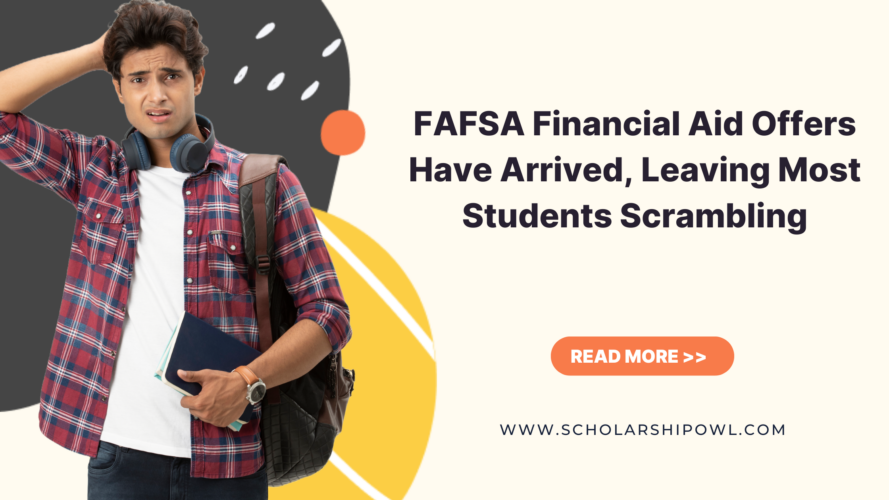In May 2024, ScholarshipOwl conducted a survey to further our understanding of the ongoing impact of the delays and technical issues associated with the rollout of the new Free Application for Federal Student Aid (FAFSA) on Gen Z students. We began studying the impact of the new FAFSA on students in February 2024 and presented our results in April and May. Our most recent survey focused on whether or not students had submitted the FAFSA yet, and for those who had, we wanted to know more about their financial aid offers, and how well those offers met their expectations.
Who participated in the survey?
In May 2024, ScholarshipOwl surveyed high school and college students on the ScholarshipOwl scholarship platform to learn more about the impacts of the new FAFSA. A total of 8,719 students responded.
Among the respondents, 63% were female, 36% were male, and 1% identified themselves as other. Nearly half (43%) were Caucasian, 27% were Black, 17% were Hispanic/Latino, 6% were Asian/Pacific Islander and 5% identified as other.
Survey questions
Question 1
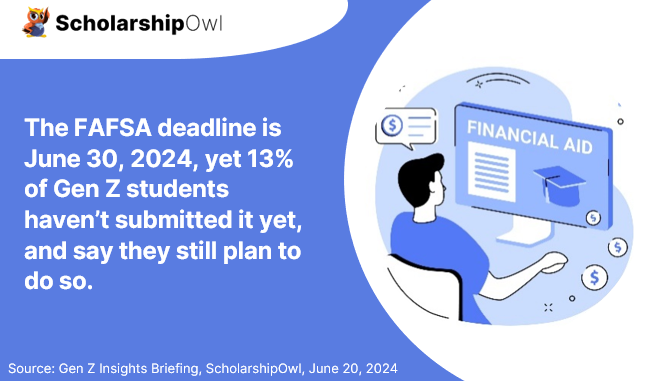
Win more scholarships with less effort
Simplify and focus your application process with the one-stop platform for vetted scholarships.
Check for scholarshipsWe began the survey by asking students, “Have you submitted the FAFSA for 2024-25?”
- 79% said they had already submitted the FAFSA
- 13% said they hadn’t submitted the FAFSA yet, but that they still plan to do so
- 4% said they had not submitted the FAFSA, and don’t plan to do so even though they will be attending college in 2024-25
- 4% said they will not be submitting the FAFSA because they won’t be in college in 2024-25
Question 2
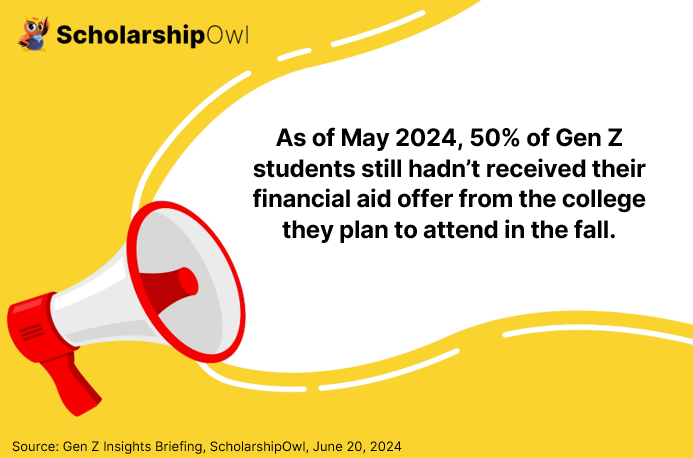
The next question was, “Have you received your full financial aid offer from the college you expect you’ll attend in 2024-25?”
- 46% said yes
- 50% said no
- 5% said they won’t be attending college in 2024-25
Follow Up Questions
The 3994 respondents who indicated they had received their financial aid offer from the college they expect to attend were asked additional questions.
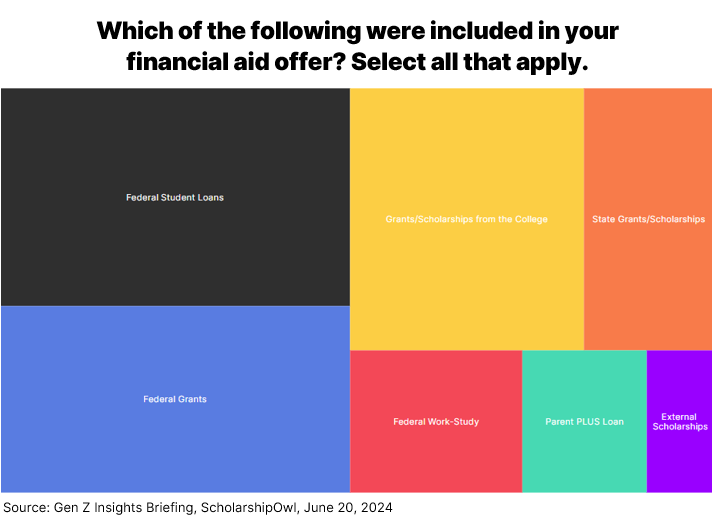
We asked, “If you received your full financial aid offer from the college you expect you’ll attend in 2024-25, which of the following were you offered? Select all that apply.”
- 48% were offered federal grants
- 25% were offered state grants or scholarships
- 45% were offered grants or scholarships from the college
- 7% were offered external scholarships from businesses or nonprofit organizations
- 18% were offered federal work-study
- 56% were offered federal student loans
- 13% were offered a Parent PLUS loan
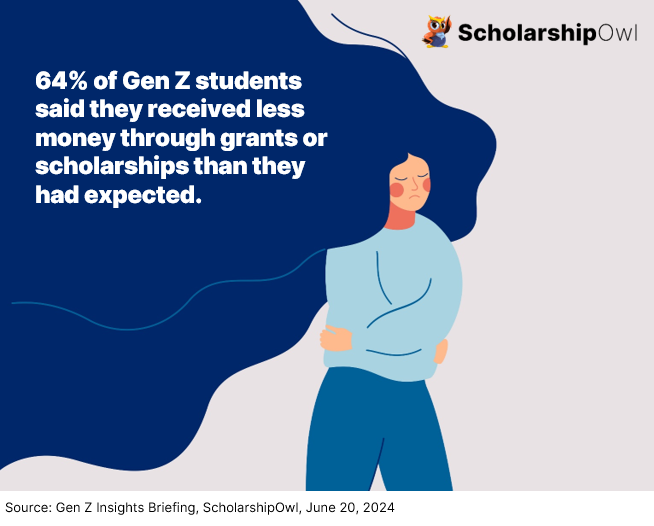
We then asked, “After reflecting on the financial aid offer you received from the college you expect to attend in 2024-25, which of the following applies to your feelings about the offer?”
- 11% said they received more money through grants and/or scholarships than they had expected
- 64% said they received less money through grants and/or scholarships than they had expected
- 22% said they received no grants or scholarships at all – they were only offered loans
- 3% said they haven’t yet received a financial aid offer from the college they expect to attend in 2024-25
Key takeaways
As we reported after our previous surveys about the new FAFSA, many media outlets have focused on the difficulties associated with the rollout, but it was assumed that these challenges would be worthwhile in the end. The U.S. Department of Education’s FAFSA website states that the new FAFSA is expected to enable 610,000 more students to meet eligibility requirements for a federal Pell Grant, with an additional 1.5 million students being able to receive the maximum Pell Grant award. Overall, the number of students submitting the FAFSA is lower compared to previous years; however, the numbers have started to pickup. As of April 26, 2024, the National College Attainment Network’s FAFSA Tracker reported that 24% fewer students had submitted the FAFSA compared to the same date the previous year, but as of June 14, 2024, that number is down only 12%. The federal FAFSA deadline is June 30, 2024, so while submissions will continue to come in through the end of June, it is unlikely that enough submissions will arrive to make up that 12%.
The results of our survey align with the submission rates indicated by the FAFSA Tracker, but our results also show that the vast majority of respondents were disappointed with the financial aid offer they received from the college they plan to attend in 2024-25, with 64% indicating that they received less money from grants or scholarships than they had expected, and 22% indicating that they received no grants or scholarships at all – they were only offered loans.
What steps can students take to ensure they can afford college?
There are a number of steps that students can take to ensure they have an affordable path to college:
- If you plan to attend college in 2024-25, it is imperative that you submit your FAFSA by June 30, 2024, which is the federal FAFSA deadline. If you haven’t yet, submit it today at www.fafsa.gov.
- If you are still waiting to receive one or more financial aid offers from colleges you applied to, contact each college’s financial aid office to ask for a status on your financial aid offer. Ask them if there is any information or documentation that you can submit that will make it easier for them to get their financial aid offer to you.
- If you are disappointed with any financial aid offers you’ve received, and if you feel that you can document why you should receive a better offer, contact the college’s financial aid office and ask them to explain how to appeal your financial aid award. Follow the steps they describe and submit your appeal right away. Note that for your appeal to have a chance at success, you’ll need to be able to explain and document why you feel your financial aid offer is incorrect. For example, if your parent/guardian recently lost their job, or if your family has large medical bills, you would need to submit documentation to support your assertion.
- Prioritize applying for scholarships with ScholarshipOwl.
- Apply for scholarships from the universities you are applying for and/or are currently attending; if you’ve already applied for these scholarships, contact the financial aid office to ask for a status on your application.
- Work part-time during the school year and full-time during breaks. Save your earnings to use for your college education.
- Once you do receive your financial aid offers, compare them and focus on choosing the most affordable college. If your first-choice school offered you a less financial aid and scholarships than other schools offered, contact your preferred school to see if you can negotiate your offer to one that is more affordable for you.
- Always consider starting at a community college, which offers a truly affordable option – and don’t forget that community colleges also offer federal and state grant aid, and they also offer scholarships. So even if you are planning to attend community college, always submit your FAFSA and always apply for scholarships!
REMEMBER: Student loans should always be a last-resort option for paying for college. Focus on debt-free sources that will enable you to graduate without the burden of owing thousands of dollars for college! Focus on applying for scholarships and jobs, NOT loans, so that you can graduate debt-free. There IS an affordable path to college – for further information, and to start applying for scholarships, visit www.scholarshipowl.com.
